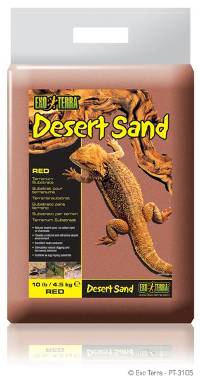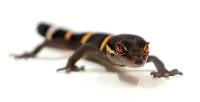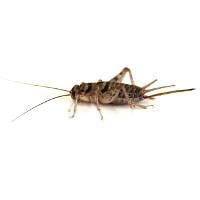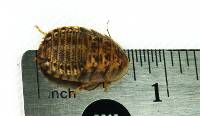Josh's Frogs
Yellow Ackie Monitor - Varanus acanthurus (Captive Bred)
Yellow Ackie Monitor - Varanus acanthurus (Captive Bred)
$399.99 0.0 out of 5 stars
(0)
0.0 out of 5 stars
(0)About This Product
Defining Characteristics:
- Small monitor species
- Mesmerizing pattern
- Spiky tail
- Diurnal diggers
- Very active, intelligent lizards
Name: Varanus acanthurus, commonly known as the Spiny-tailed Monitor or Ridge-tailed Monitor. They are a member of the Varanid sub-genus Odatria, which includes many species of dwarf monitors, most of which being endemic to Australia. They are mostly referred to as the Ackie Monitor in the reptile hobby, which is a shortened form of their latin name, given how unwieldy and generic their other common names can be.
The yellow Ackie and the red Ackie used to be distinct subspecies, being classified as V. a. brachyrus and V. a. acanthurus respectively, but due to a 2022 study involving genomic data are now simply considered localities of the same species
Recommended Enclosure Size & Setup: Despite their modest size compared to most monitors, varanids in general are a highly active genus, and therefore Ackies require a considerable amount of space. Hatchlings and juveniles can be housed in a 20-30 gallon (or a 24x18x18 enclosure), but they will very quickly need to be upgraded to a larger enclosure as they grow.
The bare minimum enclosure size for a single adult ackie should measure no less than 4’x2’x2’, but this active and inquisitive species of lizard should be provided as much space as can be feasibly provided, as they will make use of and appreciate all the space they are given.
A variety of substrates will work, provided three key elements: it holds onto moisture fairly well, it’s good for digging/burrowing (i.e. holds it shape), and a deep layer (8-12 inches) is provided. Sand/soil or sand/coco fiber mixtures work particularly well, and other elements, such as cypress mulch or orchid bark, can also be mixed in.
Provide hides under which the monitors can bury, especially underneath the basking spot; cork bark, stacked rocks, or similar items work well. Be sure that any heavy items are supported by the bottom of the enclosure and not the substrate, as these monitors will dig underneath cage decor.
While a deep substrate is key, low climbing material in the form of branches, cork bark, and other decor can be provided.
Temperature (°F): Ambient temperatures for ackie monitors should remain between 80-90 degrees. A hot basking spot is paramount for this species; they require basking spot of at least 120 to survive, although basking temperatures between 140-160 degrees are preferred. If your animal is spending most of the day basking, that is a sign that its temperatures need to be hotter, Ackie when kept properly will bask sporadically in the morning hour for roughly 15 minutes at a time, and elsewise spend most of their time exploring and foraging.
A great way to set up an Ackie Monitor basking site is to stack multiple thin slate or ceramic plates, and to put small rocks or slate pieces in between to make a ladder pattern. This formation is known as a retes stack, and will allow the animal to thermoregulate very accurately. Night temperatures can safely drop down to 70 degrees.
UV lighting is strongly recommended. Ackie are morning baskers that regularly engage with the sun in their native range. Not only do they synthesize vitamin D3 from exposure to UVB, they will also use the UVA wavelengths visible to all reptiles to properly inform basking behavior and circadian rhythm. UV lighting should be focused on their basking site and feature Ferguson zone 3 levels of UV radiation. Animals should also be provided opportunities to escape from UV exposure throughout the rest of their enclosure.
Temperature should be monitored with a digital thermometer, and the basking spot can be checked with an infrared thermometer or temperature gun.
Humidity: Although ackie monitors live in arid regions, they spend a lot of their time in humid microclimates. Ideal ambient humidity in the enclosure is higher than other arid species at around 50-65%, but can remain around 40-50% provided humid microclimates that reach 90% plus are accessible (i.e. deep substrate).
A humid hide can be provided, but the best humid hide is to provide deep burrowing substrate. It is not recommended to sacrifice ventilation to increase humidity within the enclosure. Ackie monitors should be misted around three to four times a week to raise humidity and moisten the substrate.
A water dish is recommended, but will not take away the need for regular misting.
Size: Ackie monitors sold by Josh’s Frogs are at least 5-8 inches long at the time of sale.
Ackies can vary quite a bit in body plan and size depending on locality, but most adults reach a total length of up to 24-26 inches.
Age: Ackie monitors sold by Josh’s Frogs are at least 6 weeks old. This species can live up to 15-20 years in captivity, so getting one is quite a long commitment!
Feeding: Ackie monitors are carnivores and should be provided a varied diet consisting primarily of feeder insects. Staple feeder insects should be lean and high in protein; Ackie that are fed diets that are fatty or high in uric acid are prone to developing gout. Crickets and grasshoppers fit this role well, and can be supplemented with insects like dubia, superworms, hornworms, etc. for variety.
Smaller prey items like mealworms or the occasional waxworm or butterworm can be offered as a treat to juveniles, but may be ignored by larger individuals. Keep in mind that Monitors are capable of taking down and processing larger prey items than most lizards. Juvenile Ackie can eat adult crickets and hoppers with no issue, and in general, larger feeder insects should be favored over smaller ones.
Feeder insects should be gutloaded and dusted with a vitamin/mineral supplement; we recommend Repashy Calcium Plus LoD.
In addition to their main diet of insects, whole prey items should also be provided with relative frequency (roughly one whole prey offering for every 3-4 insect feedings). Whole prey options should also be lean like their insect options. The best whole prey feeders for Ackie and other dwarf monitors are small lizards.
There are lizard feeder substitutes such as Reptilinks or Repashy Meat Pie that also work well if the Ackie accepts them, but some individuals will be more resistant to accepting these substitutes than others. Ground turkey is also a good option.
Pinky mice, while traditionally very commonly fed, should be avoided as they are very fatty. As such, Ackie that are fed diets with pinkies in their staple rotation are at risk of developing gout. The only real situations where feeding pinkies to Ackies is advised are when the animal is particularly malnourished, or for helping a female build up weight again just after laying a clutch of eggs.
Any whole prey options should be captive bred and from a reputable, clean facility.
Sexing: Ackie monitors are difficult to sex. Both species exhibit enlarged scales beneath the vent, although these appear larger in males. Males tend to have a thicker neck and wider head.
Color/Pattern: Yellow ackie monitors exhibit a brown to dark golden background color, covered with ocellated spots that range from cream, yellow, or yellow-orange color.
Social Behavior: Hatchling/juvenile ackie monitors can be housed in groups, but this must be done with caution: certain individuals may simply not get along and must be separated, or some individuals may either outgrow or be outcompeted by others. Ackie monitors that are raised together as early as possible tend to get along better than adults that are grouped together. Otherwise, when putting separately raised adults together, it is best to avoid putting same-sex individuals together that were separarately raised. Regardless, animals put together should be kept under close observation for the first few days, and individuals should be separated as needed.
Breeding: Ackie monitors will typically breed through the spring and summer months, providing up to 6 clutches per year, with clutch sizes ranging anywhere from 6-18 eggs. Brumation is not always necessary but will help cycle the monitors.
Natural Range: Yellow ackie monitors are found in arid regions of western and central Australia.
History in the Hobby: As an Australian species, only captive bred individuals are available in the US. While they remain fairly uncommon in the trade, ackie monitors are becoming more and more popular every year--and for good reason!
Links of Interest:
- Reptiles Magazine - an excellent and detailed look at ackie monitor natural history, care, and breeding
Still not sure if yellow ackie monitors from Josh's Frogs are the right pet for you? Read the reviews below and see what other customers are saying!
Shipping
After placing an order containing a live animal, you will receive a scheduling email containing our JotForm scheduling link to schedule your new pet's delivery date.
With this scheduling link, you will be able to schedule your order's delivery up to 30 days in advance. You will be able to choose a date of delivery for Tuesday-Saturday (Saturday arrival depends on the carrier's service availability) with the estimated time of arrival generally being 12pm, or 4:30pm for more rural areas. Overnight lows must be above 40°F to ship directly to you (or above 30°F for FedEx Ship Center pickups) as well as below 90°F by estimated time of arrival.
If you require further assistance, or prefer to talk to one of our Customer Service agents, please feel free to reach out to our [email protected] email or our phone line 1-800-691-8178.
Other Customers Also Bought
Customer Reviews
0.0 out of 5 stars
Review data
5 star reviews
- 0%
4 star reviews
- 0%
3 star reviews
- 0%
2 star reviews
- 0%
1 star reviews
- 0%






